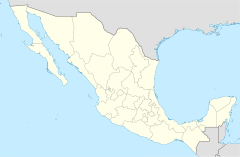Laguna Madre (Mexico) facts for kids
Quick facts for kids Laguna Madre |
|
|---|---|
| Laguna Madre and Río Bravo Delta Biosphere Reserve Laguna Madre and Río Bravo Delta Flora and Fauna Protection Area |
|
|
IUCN Category VI (Managed Resource Protected Area)
|
|
| Location | Tamaulipas, Mexico |
| Nearest city | Tamaulipas |
| Area | 5,728.08 km2 (2,211.62 sq mi) |
| Designation | Flora and fauna protection area (national) biosphere reserve (international) |
| Designated | 2005 (national) 2006 (international) |
| Administrator | National Commission of Natural Protected Areas |
| Official name: Laguna Madre | |
| Designated: | 2 February 2004 |
| Reference #: | 1362 |
The Laguna Madre is a long, shallow lagoon found along the coast of northeastern Mexico. It stretches for over 200 kilometers (about 124 miles) in the state of Tamaulipas. This special water body runs from the Río Bravo Delta in the north down to the mouth of the Soto la Marina River in the south.
The Laguna Madre is separated from the Gulf of Mexico by several barrier islands. These islands act like natural walls, protecting the lagoon. On its western side, the lagoon is bordered by the mainland of Tamaulipas. It is located near the cities of Matamoros, San Fernando, and Soto la Marina.
Did you know there's another Laguna Madre in the United States? It starts north of the Río Bravo Delta and goes up to Corpus Christi Bay in southern Texas. Both lagoons and the delta together form one big natural area. This entire area is about 275 miles (443 km) long.
Contents
What Makes Laguna Madre Special?
The Laguna Madre is very shallow. Its average depth is only about 0.9 m (3.0 ft), which is less than a meter! This means you could almost stand in most parts of it.
The lagoon connects to the ocean through only two small openings. Because of this, the ocean's tides don't affect it much. Instead, the weather plays a bigger role in how the water moves. Strong winds can even change the water level by as much as a meter.
Salty Waters
Scientists call Laguna Madre a hypersaline lagoon. This means it's usually much saltier than the ocean. It's almost completely surrounded by land and is in a dry area.
The amount of salt in the water can change a lot. After heavy rains, it can become less salty. But during dry times, it can get super salty, sometimes more than three times saltier than the ocean!
Amazing Plants and Animals
The Laguna Madre and the Río Bravo Delta are home to a huge variety of life. The National Biodiversity Information System (CONABIO) has found over 1,515 different kinds of plants and animals here. Some of these species are at risk, and some are not native to the area.
Watery Homes
In the water, you can find mangroves, which are special trees that grow in salty coastal waters. There are also large areas covered with seagrass beds. These underwater meadows are important homes for many sea creatures. One common type of seagrass here is Halodule wrightii.
Bird Paradise
Laguna Madre is a very important place for birds, especially in winter. It's like a warm vacation spot for 26 different kinds of waterfowl. You might see birds like the grey plover (Pluvialis squatarola) and the piping plover (Charadrius melodus).
Huge numbers of redhead ducks (Aythya americana) and northern pintail ducks (Anas acuta) come here, sometimes over 100,000 of them! There are also 144 types of birds that live here all year round. The lagoon is part of a major path for birds migrating along the Gulf Coast.
Land Animals
The land around the lagoon is part of the Tamaulipan pastizal. This area is a mix of grasslands and dry shrublands. It's one of the best-preserved natural areas in Mexico.
This region also acts as a natural pathway for large mammals. Animals like jaguars, ocelots, oncillos, pumas, and lynx use this area to move around.
Protecting Laguna Madre
Many groups worked hard to protect Laguna Madre. These included organizations like Pronatura Noreste, universities, local governments, and local communities.
Because of their efforts, in April 2005, the Mexican government declared Laguna Madre and the Río Bravo Delta a flora and fauna protection area. This means the area is legally protected. It covers about 1.4 million acres (5,700 square kilometers) in the municipalities of Matamoros, San Fernando, and Soto la Marina.
Then, in 2006, UNESCO recognized the area as an international biosphere reserve. This gives it even more protection on a global scale.
See also
 In Spanish: Laguna Madre (Tamaulipas) para niños
In Spanish: Laguna Madre (Tamaulipas) para niños


